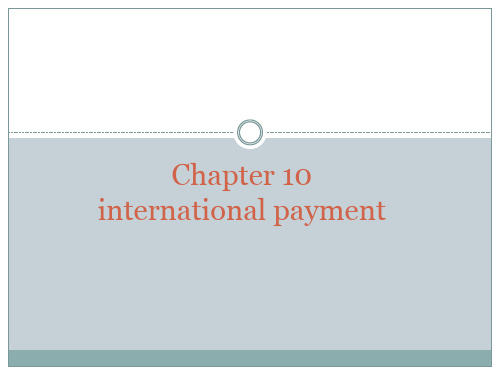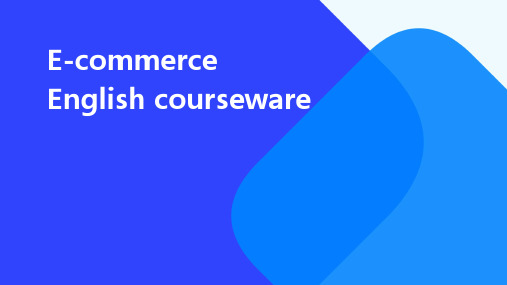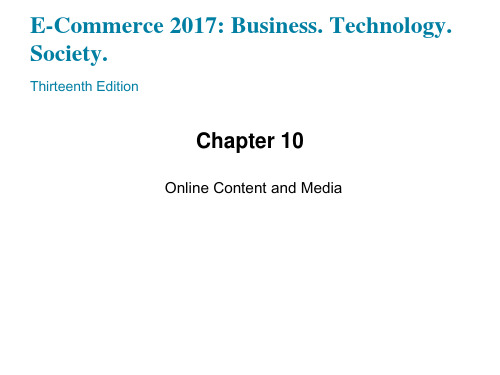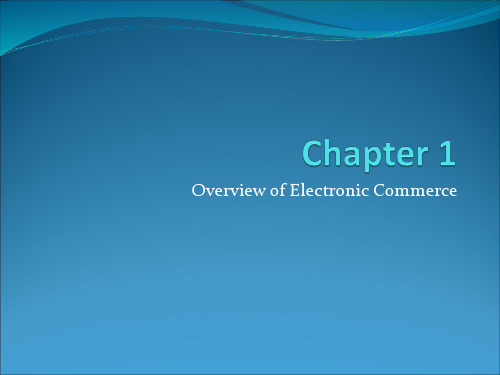电子商务英文版最新版课件ch10
商务英语课件chapter 10 (2)

transferring title to the goods are not given to the buyer until he has paid the value of the draft issued against him.
Payment in Advance预付货款 Payment in advance signifies that the importer pays
the exporter before delivery of the goods. (used down payment)
Open account Business赊账业务 Under this device, the exporter sends his shipping
Discussion
Advantages and disadvantages of L/C from the perspective of exporters and importers respectively.
Confirmed L/C 保兑信用证 (Unconfirmed L/C) Revocable L/C 可撤销信用证 (Irrevocable L/C) Sight L/C (L/C at sight) 即期信用证 (Time L/C) Transferable L/C 可转让信用证 (Non-transferable L/C) Divisible L/C可分割信用证 (Indivisible L/C)
Collection 托收
After the exporter has shipped the goods or rendered services to his customer abroad, he draws a bill of exchange on the latter with or without shipping documents attached thereto and then gives the draft to his bank together with his appropriate collection instructions. Thus, a collection is usually processed through banks acting as the intermediary.
英文版 电子商务课件(部分) 压缩01

• renting or buying the facilities in which the speakers are made and stored,
❖ Beginning in 2003, with the general economy still in the doldrums, electronic commerce began to show signs of new life. Companies that had survived the downturn were not only seeing growth in sales again, but many of them were showing profits.
❖ From humble beginnings in the mid-1990s, electronic commerce grew rapidly until 2000, when a major downturn occurred.
▪ Many people have seen news stories about the “dot-com boom” followed by the “dot-com burst” or the “dot-bomb.”
▪ In the 2000 to 2003 period, many industry observers were writing obituaries(讣告) for electronic commerce. Just as the unreasonable expectations for immediate success fueled the high expectations during the boom years, overly gloomy news reports colored perceptions during this time.
Chapter10电子商务与国际贸易单证《国际商务单证双语》PPT课件

10.2 电子单证与电子支付
10.2.2 E⁃Payment 电子支付
• 1. Electronic Money • Electronic money refers to exchanging
a certain amount of cash or deposits from the issuer and obtaining data representing the same amount, or transferring the balance in the bank through some electronic means through the fast payment service launched by banks and third parties, so that transactions can be conducted.
10.1 电子商务与国际贸易
电子商务对国际贸易的影响:
(1)电子商务使国际贸易得到发展。 (2)虚拟市场的出现改变了国际贸易的环境。 (3)虚拟公司的出现使国际贸易操作的监管产生差异。
(4)国际贸易管理和运作改变了很多。
CHAPTER
ONE
10.2 E⁃Documents and E⁃Payment 电 子单证与电子支付
(3)The emergence of virtual company makes difference of the operating bobby of international trade.
(4)The operation and management of international trade change a lot.
10.2 电子单证与电子支付
10.2.2 E⁃Payment 电子支付
电子商务英语课件

Sentence patterns for e-commerce payment
04
E-commerce English Writing
E-commerce email writing style
Use a professional and friendly tone, maintain a consistent format, and ensure the email is easy to read.
The definition of e-commerce
The origins of e-commerce can be traced back to the early days of the internet in the 1990s, when online marketplaces such as eBay and Amazon emerged.
As the internet became more widespread and technology advanced, e-commerce has grown exponentially, encompassing a wide range of industries and sectors, including retail, travel, finance, and more.
E-commerce transactions are typically conducted online, using websites or mobile applications as platforms for product display, order placement, payment processing, and delivery.
商务英语综合教程第二册Unit 10 Electronic Commerce_OK

➢Electronic Funds Transfer EFT 电子资金转帐
➢supply chain management 供应连锁管理
➢Electronic Data Interchange (EDI) 电子数据交换(EDI) EDI,是两个 组织之间结构化商业数据(如订单、发票和货运通知单等)的电子交 换,通常在供应商和客户之间发生。例如,EDI可以基于记录级使 用户能用自己的计算机向供应商的计算机发出货物订单。
• Business-to-Business (B2B)
• Business-to-Consumer (B2C)
• Business-to-Employee (B2E)
• Business-to-Government (B2G) (also known as
Business to Administration or B2A)
Unit 10 Electronic Commerce
2021/6/27
1
Warm-up Activities
Background Information
Text Analysis
Extended Activities
Writing
2021/6/27
2
Warm-up Activities
• I. Pair works • What do you know about Online shopping? Have you ever tried it? Talk about it with your partne
time and unnecessary formal
ities. That's why e-commerc
e is preferable to traditional
电子商务讲解课件(英文)Lecture

Effective channels for customers to get help and resolve issues.
03
E-commerce Businesses
Marketplace
Marketplace Amazon Alibaba eBay
A platform that brings together buyers and sellers to facilitate transactions.
A crowdfunding platform that allows individuals or groups to raise funds for personal causes or charitable
projects.
Airbnb
A peer to peer e-commerce platform that allows
01
02
03
起始阶段
20世纪90年代初,电子商 务出现,以静态网页展示 产品信息。
发展阶段
20世纪90年代末至21世 纪初,电子商务平台兴起 ,在线购物逐渐普及。
成熟阶段
21世纪中期至今,移动支 付、社交电商、跨境电商 等多元化模式涌现。
Types of E-commerce
01
02
03
04
B2B (Business-to-Business) :企业与企业之间的电子商务
Bitcoin, Ethereum, etc., used for secure, decentralized transactions.
Delivery and Logistics
In-store pickup
电子商务英文版最新课件ec13_ppt_ch10_accessible

• Industry convergence – Merger of media enterprises into firms that create and cross-market content on different platforms
production business • Continued growth of online video and music • E-book sales growth slows • Digital music sales top physical sales • Console games flatten as mobile games soar
• Class Discussion – Do you subscribe to any online video streaming services? If so, which ones? – What sites have given you the best overall viewing or entertainment experience, and why? – What are the advantages of watching traditional television over watching online TV and films?
Trends in Online Content (1 of 2)
• Mobile platform accelerates the transition to digital content • Distributors become significant players in content
电子商务英语课件1

电子商务英语课件1引言随着全球化的加速和互联网技术的飞速发展,电子商务已经成为当今世界经济发展的重要引擎。
本课件旨在为英语学习者提供电子商务领域的专业词汇和表达方式,以便更好地理解、参与和推动电子商务的发展。
第一部分:电子商务概述1.1电子商务的定义1.2电子商务的分类(1)企业与消费者之间的电子商务(B2C):企业通过网络向消费者销售商品或提供服务。
(2)企业与企业之间的电子商务(B2B):企业之间通过网络进行商品或服务的交易。
(3)消费者与消费者之间的电子商务(C2C):消费者通过网络平台进行商品或服务的交易。
1.3电子商务的优势(1)便捷性:消费者可以随时随地通过互联网进行购物,不受时间和地点的限制。
(2)成本节约:电子商务减少了实体店铺的租赁、人员等成本,降低了商品价格。
(3)信息对称:电子商务平台为买卖双方提供了丰富的商品信息和评价,降低了信息不对称的风险。
(4)个性化服务:电子商务可以根据消费者的购物喜好和需求提供个性化的推荐和服务。
第二部分:电子商务的关键技术2.1互联网技术互联网是电子商务发展的基础。
它为电子商务提供了信息传输、数据存储和处理等基础设施。
随着5G技术的普及,互联网速度将进一步提升,为电子商务带来更广阔的发展空间。
2.2数据库技术数据库技术是电子商务中存储、管理和处理大量数据的关键技术。
通过数据库技术,企业可以实现对消费者数据的挖掘和分析,为市场营销和决策提供有力支持。
2.3网络安全技术网络安全是电子商务发展的重要保障。
电子商务平台需要采用加密技术、身份认证、防火墙等技术来确保交易安全,保护消费者隐私和权益。
2.4移动支付技术移动支付是电子商务的重要组成部分。
随着智能方式的普及,移动支付技术为消费者提供了便捷的支付方式,进一步推动了电子商务的发展。
第三部分:电子商务的发展趋势3.1跨境电子商务随着全球化的发展,跨境电子商务将成为电子商务的重要组成部分。
企业可以通过跨境电子商务拓展国际市场,实现全球化经营。
国际商务英语课文电子版lesson(10)

国际商务英语课⽂电⼦版lesson(10)Lesson10 International Payment Generally speaking, it is not very difficult for buyers and sellers in domestic trade to get to know each other’s financial status and other information, and payment is likely to be made in a straightforward manner,say(for example)by remittance or by debiting the debtor’s account. In international trade, however, things are far more complicated. Purchase and sale of goods and services are carried out beyond national boundaries, which make it ratherdifficult for the parties concerned in the transaction to get adequate information about each other’s financial standing and creditworthiness (资信;信誉). Therefore, mutual trust is hard to build. Both the exporter and importer face risks as there is always the possibility that the other party may not fulfill the contract.For the exporter there is the risk of buyer default(不按期付款). The importer might fail to pay in full for the goods. He might go bankrupt.His government might, for various reasons, ban(禁⽌)trade with the exporting country or ban imports of certain commodities. The buyer might run into difficulties getting the foreign exchange to pay for the goods. It is even possible that the buyer is not reliable and simply refuses to pay the agreed amount on various excuses.On the part of the importer, there is the risk that the shipment will be delayed, and he might only receive them long after payment.The delay may be caused by problems in production or transportation, and such delays may lead to loss of business. There is also a risk that wrong goods might be sent as a result of negligence(疏忽⼤意)of the exporter or simply because of his lack of integrity (honesty).Political risks such as war, quotas, foreign exchange control; commercial risks like market change and exchange rate fluctuations(波动); and even language barriers all add upto(increase)the problems in international trade. Because of these problems and risks, exporters are hesitant to release their goods before receiving payment, while importers prefer to have control over the goods before parting with their money. Various methods of payment have been developed to cope with different situations in international trade. When the political and economic situation in the importing country makes payment uncertain or when the buyer’s credit standing isdubious (doubtful), the exporter may prefer cash in advance or partial cash in advance. In this case, the importer has no guarantee that the exporter will fulfill his obligations once he has made payment by cash. If the buyer and the seller know each other well, they may decide to trade on open account. This means that no documents are involved and that legally (in terms of law) the buyer can pay anytime. The seller loses all control over the goods once they have been shipped. Sales on thisbasis are usually paid for by periodic payment, and obviously the exporter must have sufficient financial strength经济实⼒to carry the cost of the goods until receiving payment. If the exporter wishes to retain(保留)title or ownership(所有权)to the goods, he can enter into consignment transactions. This means the exporter has to send his goods abroad and will not get payment until the goods are sold. If not sold, the goods can be shipped back. Therefore, this arrangementshould only be made with full understanding of the risks involved and is preferably to be limited to stable countries where the exporter has a trusted agent to look after his interest.A lot of international transactions are paid for by means of the draft(汇票), which, also referred to as the bill of exchange, is an unconditional(⽆条件的)order to a bank or a customer to pay a sum of money to someone on demand(⽴即)or at a fixed time in the future.The person who draws(开⽴)the draft,usually the exporter, is called the drawer(出票⼈), and the person to whom the draft is drawn is called the drawee(受票⼈). There is yet another party payee(收款⼈), i.e. the person receiving the payment, who and the drawer are generally but not necessarily the same person, as the drawer can instruct the drawee either to pay “to the order of ourselves” or to the order of someone else, for instance, the bank.A draft is either a sight draft ora usance draft (also called tenor draft or term draft). The former calls for (needs)immediate payment on presentation(提⽰) to the drawee while the latter is payable at a later date, e.g. 30, 45, 60, or 90 days after sight or date. A draft is either clean (clean draft 光票) (without documents) or documentary (documentary draft跟单汇票). In the latter case, the draft is accompanied (attached)by the relevant documents such as the bill of lading, the invoice, the insurance policy etc.In documentary collection ( 跟单托收), the exporter sends the draft and the shipping documents运输单据representing title tothe goods to his bank, which forwards (sends)them to another bank in the importer’s country, which in turn contacts the customer (importer). In the case of documents against payment (D/P)付款交单, documents will not be released to the importer until payment is effected执⾏. There are D/P at sight and D/P after sight. The former requires immediate paymentby the importer to get hold of the documents. The latter gives the importer a certain period after presentation of the documents, but documents are not released to him until he actually pays for the merchandise货物. In the case of documents against acceptance (D/A)承兑交单, documents are handed over to the importer upon his acceptance(承兑)of the bill of exchange drawn by the exporter. Payment will not be made until a later date. D/A is always after sight.So far as the exporter’s interest is concerned, D/P at sight is more favorable than D/P after sight, and D/P is more favorable than D/A. In actual trade, payment by collection should be accepted with discretion (⼩⼼). It is usually used when the financial standing of the importer is sound(良好的), or when the exporter wishes to push the sale of his goods, or when the transaction involves only a small quantity. Otherwise, the letter of credit is generally preferred.。
电子商务专业英语Unit BB Ecommerce课件

vertical sectors, such as
或者IT行业)提供营销服务,
construction, healthcare or IT, and 其他的一些机构则采用全局
others take a more holistic
法来进行品牌营销。
电子商务专业英语Unit BB Ecommerce
12
Key Sentences
Even worse, making it difficult
更糟糕的是,人们退订的困难
for people to unsubscribe can
9
Key Sentences
B2B营销兴起于巨大的B2C营销环境的阴 影之下,因而企业越来越认识到在生意 经营中全局法的重要性,在这种方法下, 他们不仅仅只关注于客户,也要关注他 们如何被自己的员工和其他利益相关者 (如合作伙伴,供应商和股东)看待。
电子商务专业英语Unit BB Ecommerce
E-mail marketing
Promote
Location
Schedule
电子商务专业英语Unit BB Ecommerce
8
Key Sentences
Business-to-Business (B2B) marketing emerging
from under the shadow of its larger business-to-
consumer (B2C) marketing cousin as businesses are
increasingly recognizing the importance of taking
an holistic approach to how they conduct their
电子商务(全套英文版662页PPT课件)

click-and-mortar (click-and-brick) organizations Organizations that conduct some e-commerce activities, usually as an additional marketing channel
consumers, and society. 10. List and describe the major limitations of EC.
2020/12/16
1-3
Electronic Commerce: Definitions and Concepts
electronic commerce (EC)
2020/12/16
1-4
Electronic Commerce: Definitions and Concepts
MAJOR EC CONCEPTS
Pure Versus Partial EC EC Organizations
brick-and-mortar (old economy) organizations Old-economy organizations (corporations) that perform their primary business offline, selling physical product
intranet An internal corporate or government network that uses Internet tools, such as Web browsers, and Internet protocols
unit 5Mobile Commerce《电子商务英语》PPT课件

telecommunication network.
Text
Mobile Commerce
II.Characteristics of M-commerce
1.Convenience and
Text
Mobile Commerce
IV.Opportunities for M-commerce
One of the driving forces for increased use of mobile devices is the
desire to change business processes inside the enterprises,rather
• affluent
• [′æfluənt]
• adj.富裕的
• handheld
• [′hændˌheld]
• adj.手提式的,便携式的
New Words
• schematic
• [ski:′mætik]
• n.示意图、原理图
• hassle-free
• [′hæsəl′fri:]
• adj.方便的,一站式服务的
用的是公用频段。
Notes
LAN:Local Area Network的缩写,即局域网。
WAN:Wide Area Network的缩写,即广域网。
Notes
4.Banks in China notify customers about
their current balance or the latest
interception or attacks from unauthorized
电子商务英语实用教程十

If They Can't Find It They Won't Buy It
Slow Site = Slow Business Simple Sites Sell Successfully If You Don't Know Your Customers, You Don't Know Your Business Not Everyone Is a Talented Web Site Designer More Time on Site Means More Sales The “Experts” Aren't Always Right
10 things to think about that may save you form some of the more common mistakes:
If It Was That Easy, We'd All Be Doing It. Marketing Is King You Can't Sell What They Don't Want
rave on about 大肆鼓吹,情绪激动地表述
Take a look at the Google home page. 请看一下Google 主页。
《实用电子商务英语》unit10

Lead-in
Read the defination of social media and then think about the following questions.
PPT模板下载:行业PPT模板: 节日PPT模板:素材下载: PPT背景图片:图表下载: 优秀PPT下载:教程: Word教程: 教程: 资料下载:课件下载: 范文下载:试卷下载: 教案下载: 字体下载:
目录
CONTENTS
Grammar Review(名词性从句)
Supplementary Reading (社交客户关系管理)
E-commerce-Related Knowledge
PPT模板下载:行业PPT模板: 节日PPT模板:素材下载: PPT背景图片:图表下载: 优秀PPT下载:教程: Word教程: 教程: 资料下载:课件下载:
范文下载:试卷下载:
教案下载:
字体下载:
(客户关系管理)
Part Ⅰ Lead-in
impression of the company. Once visitors have developed this favorable impression, thto buy on this visit or bookmark the site for a return visit. 6
management? How?
Part Ⅱ Reading
PPT模板下载:行业PPT模板: 节日PPT模板:素材下载: PPT背景图片:图表下载: 优秀PPT下载:教程: Word教程: 教程: 资料下载:课件下载: 范文下载:试卷下载: 教案下载: 字体下载:
- 1、下载文档前请自行甄别文档内容的完整性,平台不提供额外的编辑、内容补充、找答案等附加服务。
- 2、"仅部分预览"的文档,不可在线预览部分如存在完整性等问题,可反馈申请退款(可完整预览的文档不适用该条件!)。
- 3、如文档侵犯您的权益,请联系客服反馈,我们会尽快为您处理(人工客服工作时间:9:00-18:30)。
3
Online Security Issues Overview
• Individuals and businesses have had concerns about security since Internet became a business communications tool
– Increasing with steady increase in sales all types of financial transactions
• Chapter topics
– Key security problems – Solutions to those problems
– Crackers or hackers obtain unauthorized access to computers and networks
• White hat (good) and black hat (bad) hackers
• Companies must identify risks, determine how to protect assets, and calculate how much to spend
11
© Cengage Learning 2017
FIGURE 10-2 Requirements for secure electronic commerce
12
Establishing a Security Policy (cont’d.)
• Security policy points
– Authentication: Who is trying to access site? – Access control: Who is allowed to log on to and
Web site
14
Cookies and Web Bugs
• Internet connection between Web clients and servers accomplished by multiple independent transmissions
– No continuous connection (open session) maintained between any client and server
channels between computers • How to implement security on Web server computers • What organizations promote computer, network, and
Internet security
2
Introduction
• Man-in-the-middle exploit
• Necessity refers to preventing data delays or denials (removal)
9
Establishing a Security Policy
• Written statement of: assets to protect and why, who is responsible for protection and acceptable and unacceptable behaviors
• Password management tools are popular solutions for maintaining multiple complex passwords
– Requires a single, master password for access – Weak link when hackers access master passwords
– Selected to satisfy Figure 10-2 requirements – Provides a minimum level of acceptable security
• All security measures must work together to prevent unauthorized disclosure, destruction, or modification of assets
access site? – Secrecy: Who is permitted to view selected
information? – Data integrity: Who is allowed to change data? – Audit: Who or what causes specific events to occur,
• Business computers initially adopted military’s security methods
– Networks and other factors have increased number of users accessing computers
– Computers now transmit valuable information
• Extent and expense depends on importance of asset at risk
6
Computer Security and Risk Management (cont’d.)
• Risk management model: four general actions based on impact (cost) & probability of physical threat
• Threat is anything posing danger to computer assets
– Countermeasures are procedures (physical or logical) that recognizes, reduces, and eliminates threats
7
© Cengage Learning 2017
FIGURE 10-1 Risk management model
8
Elements of Computer Security
• Secrecy refers to protecting against unauthorized data disclosure and ensuring data source authenticity
– Also applicable for protecting Internet and electronic commerce assets from physical and electronic threats
– Eavesdropper (person or device) that listens in on and copies Internet transmissions
• Cookies are small text files Web servers place on Web client to identify returning visitors
10
Establishing a Security Policy (cont’d.)
• Once policy is written and approved resources are committed to implement the policy
• Comprehensive security plan protects system’s privacy, integrity, availability and authenticates users
• Changes have made the need for comprehensive security risk controls more important than ever
5
Computer Security and Risk Management
• Asset protection from unauthorized access, use, alteration, and destruction
4
Origins of Security on Interconnected Computer Systems
• Modern computer security techniques developed by US Department of Defense
• “Orange Book”: rules for mandatory access control
• Integrity is preventing unauthorized data modification
– Integrity violation occurs when an e-mail message is intercepted and changed before reaching destination
– Addresses physical and network security, access authorizations, virus protection, disaster recovery
• Steps to create security policy
– Determine which assets to protect from which threats – Determine access needs to various system parts – Identify resources to protect assets – Develop written security policy
